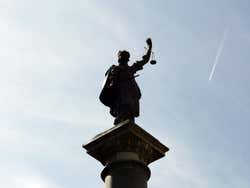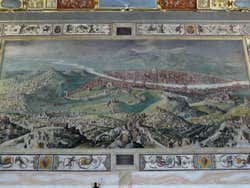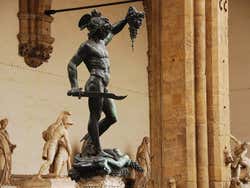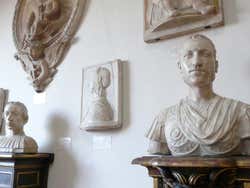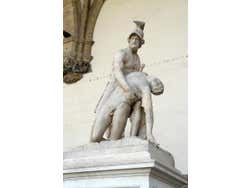
History of Florence
Get to know the history and the principal characters in the history of Florence from its foundation up to the present day. The Tuscan capital is a veritable treasure trove of art and culture.
In the beginning, Florence was a fortified camp called Florentia that lay on the Via Cassia, a Roman road that ran between the foothills of the Apennines and the western coast of Italy, on the Tyrrhenian sea. It was the principal route between Rome and the North.
Florence was originally founded by the Etruscans between the 6th and 7th centuries BC. This civilisation came from Asia Minor and then settled in the Tuscany area. Since Florence was located at the base of the Apennine Mountains, the Etruscans preferred to build their town on a slope a few kilometres away for better protection, founded where modern day Fiesole is located. During this period, Florence depended completely on Fiesole.
The objects and archaeological remains found in this area are evidence of the Etruscan’s presence in the Florentine region. To see these startling findings, we recommend going to the National Archaeological Museum of Florence.
In 395 BC, the Etruscan civilisation was suppressed by Rome. In the following years, the Romans founded Florentia, a town established on the ashes of the Etruscan village.
During the Middle Ages, Florence became more influential than its neighbouring Fiesole, known as Faesulae when it was conquered by the Romans as a result of its agricultural potential and its great location on the Via Cassia. In the 6th century, the Lombards ruled Florence.
Florence in the Middle Ages
In 774, the town was conquered by Charlemagne and was made part of the Carolingian Empire. In 1115, with Matilda of Tuscany’s death and the subsequent disputes over the kingdom, Florence rebelled and defeated the imperial vicar reconquering the castles and nearby villages to ensure the safety of their trade.
From 1115 it was governed by an autonomous medieval commune, and In 1125 Fiesole was conquered and its inhabitants expelled. Most of the town’s citizens settled in Florence. During this period Firenze became allies with Pisa, which sold the city the boats it needed for its commerce.
Siena was the city’s main rival and the banks of both cities fought for the clientele of the Holy See, a rivalry which meant In 1218 Florence was plunged into war against Siena for the control of Tuscany.
During the 12th and 13th centuries, the Florentines took part in the wars between the Guelphs and Ghibellines, factions that fought for the succession of the imperial crown. The Guelphs supported the Pope and were against the noble privileges, and the Ghibellines, were supported by the Holy Roman Emperor and opposed the Pope. Florence was predominantly Guelph. Because of this conflict, the aristocracy was weakened and lost power over Florence in 1293. The power shifted to the mercantile elite and guilds.
During this period, Florence had risen and become the most powerful and prosperous city in Tuscany, given that Pisa had been overthrown by Genoa in 1284 and Siena was declining. Florence was one of the most active cities in Italy. The businesses were run by families, and many had crossed frontiers and had launched interests in Western Europe. The oldest companies were split into feuding “White” and “Black” factions (1300 – 1302), where the Guelphs became divided and suffered grave consequences. The political conflicts did not prevent the city from becoming one of the most dominant and flourishing cities in Europe. Florence opened its commerce to Western Europe, and its power compared to Venice and was concentrated on the Mediterranean countries.
A testimony of Florence’s power is its own gold currency called the “fiorino d’oro” or florin, introduced in 1252. This currency would remain one of the most important currencies, along with the Venetian ducat, over the following three centuries.
From 1326 new companies were dedicated to commerce, finance and industrial activities, especially banking. The Florentines were the first to organize a large-scale loan, lending money to the European sovereigns, charging them interest rates. An economic crisis during the 14th century and the Hundred Years’ War bankrupted most of these companies. Years later, new companies dedicated to banking were created, but this time they were more cautious.
In 1406 Florence conquered Pisa and became a maritime power. Most wealthy merchants dedicated a part of their fortunes to build churches and chapels to ensure the salvation of their souls. They also transformed their houses into magnificent palazzos.
Renaissance art can be traced back to the 15th century, coinciding with the last crisis of the power in Florence, which finally lead to the rise in power of the Medici family.
Since the 14th century, there were still many conflicts in the political life of Florence, which was controlled by an oligarchy. It was based on an army of mercenaries. The Albizzi family, the Medici's biggest rivals (head of the “popolo grasso”, a wealthy middle class of merchants and businessmen), and the Ricci (head of the “artes medias”, minor tradesmen and entrepreneurs), came together to revolt against the oligarchy (1343) and later fought for power. The Ciompi (wool carders) conquered the power in 1378. With the help of the Albizzi, the “popolo grasso” recovered power in 1382 until 1434.
The Medici
The Medici family were the wealthiest in Florence and had great political ambition that was finally achieved by Cosimo de’ Medici. He had no title, yet had important alliances and patronages, and thanks to these managed to control Florence from behind the scenes from 1434 onwards, banishing or ruining his adversaries.
The Medici family were neither aristocrats nor dynastic heirs, but rose to power and wealth slowly, surely, and inconspicuously. Their business was based on both art and other activities. For example, Cosimo together with the Pope, had total control over the alum industry (a kind of aluminium based salt used in the dying process), and the Medici family progressively became even wealthier.
The Medicis were erudite sponsors of a few of the Renaissance’s greatest artists, including Leonardo da Vinci, Michelangelo and Donatello.
The House of Medici was a family that closely connected to Florence’s history. They would control the city on and off during the following 350 years. Throughout these centuries, Florence would stand out for its wealth and power, as an art and cultural epicentre and as the main “bank” of the Pope.
Lorenzo de’ Medici was one of the most enthusiastic patrons of Renaissance art and would mark a turning point in the history of art history in Florence. After his death, his eldest son, known as Piero the Unfortunate, became ruler of the city. The Florentines rebelled against him and banished him from Florence in 1494. Thus, the first period of Medici control was over.
The wealthiest merchants established a republic, where Niccolò Machiavelli was appointed senior official in the Florentine Republic. Artists from all over Italy and Europe flocked to Florence to become apprentices of the most renowned artists. Once they had gained enough experience, they would move to Rome or Milan, which were at that time more stable and prosperous.
In 1512, the Medici family regained the power over Florence thanks to the Spaniards. Their rule would last 15 years until they were exiled for a second time by the Florentines on 16 May 1527. A republic was then re-established.
Charles V sieged the city in 1530 with the support of Pope Clement VII and appointed his son-in-law Alessandro de’ Medici as ruler of the city. His successor Cosmin II annexed Siena in 1555. The Medici would rule over Florence for the following two centuries.
The Medici line died out in 1737 and the Duke of Lorraine, husband of Maria Theresa of Austria, came to power, meaning the inclusion of Florence in the territories of the Austrian crown.
The Congress of Vienna, held to find a long-term peace arrangement for Europe, led Tuscany to be returned to the Kingdom of Italy.
Modern Age
In 1861 the last Grand Duke of Tuscany was overthrown in a plebiscite and the region was annexed to the United Kingdom of Italy.
Florence substituted Turin as capital of the country in 1865, and six years later it was moved to Rome, when the French troops retreated and the area was added to the newly formed kingdom.
During the 19th century, the number of inhabitants in Florence doubled, while the population tripled during the 20th century due to the increase of tourism, commerce and industrial growth.
Over the course of World War II, the city was occupied by German troops from 1943 to 1944. The Florentines opposed the occupying German forces brutally and incessantly until the Germans were pushed out of the city by a popular liberation rising in August 1944.
As the Germans retreated from Florence, they mined all the bridges of the city except the Ponte Vecchio, which is thought to have been spared because of its artistic value.
In 1966, the Arno River flooded part of Florence’s historic centre killing 34 people and causing incredible damage to the city’s artistic heritage. Thousands of volunteers came to Florence from all over the world to try and rescue as many works of art as possible, some of which were damaged for good. The Florentines would call these helpers “Angels of Mud” (Angeli del fango). This gesture of support, love and affection for the city demonstrates just how Florence is regarded internationally.
